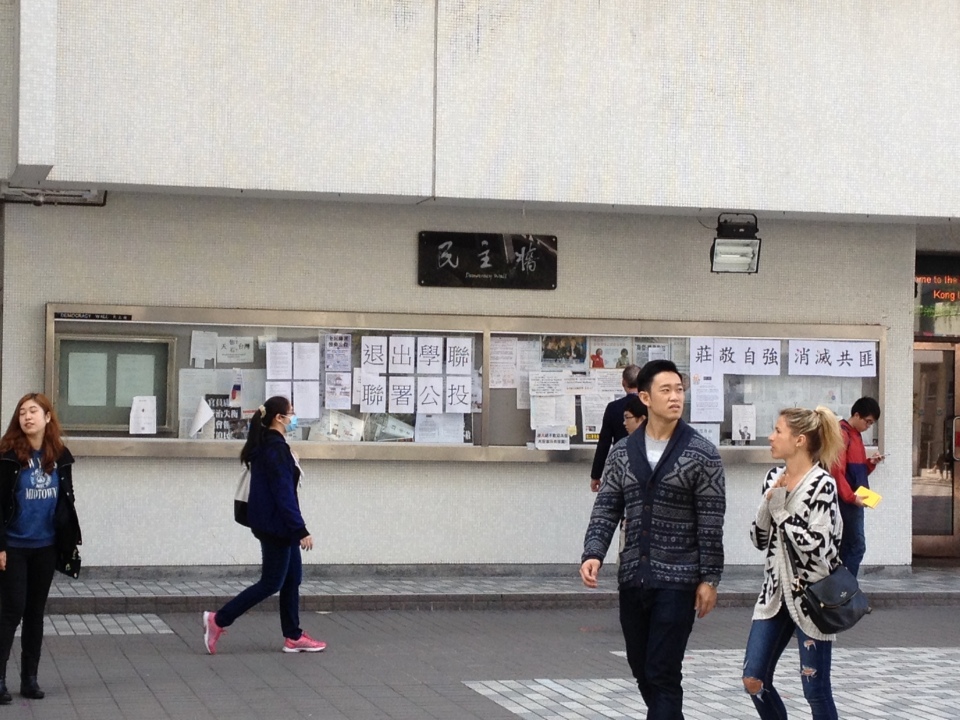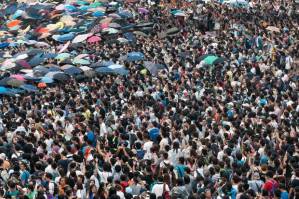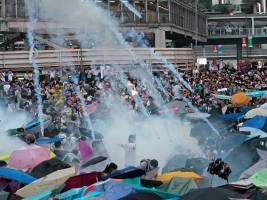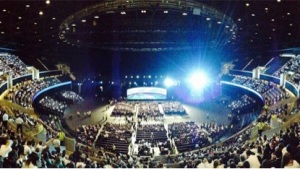Guest blog by Carmen Tong, Lecturer in the Department of Sociology, University of Hong Kong
A discussion of the diverse role that young people played in the Umbrella Movement and the problems and potentials involved in youth-led politics.
Young people in Hong Kong today, and probably young people everywhere, have long been stereotyped with an apparent lack of interest in politics. Frequently accompanying this stereotype is a debate on generational shifts in young people’s political interests and the weakening of their participation in formal political events. In the recent Umbrella Movement, however, these stereotypes were shattered. Statistically, 61% of the protestors were age 29 or below, and only 15% had never previously participated in any rally, protest or demonstration (1). In other words, not only was the Umbrella Movement led by young people (the two student groups Scholarism and HKFS), it was also a social movement dominated by the younger cohorts who were not novices in social activism.
While it was the student leaders who caught the international and local spotlight as the organisers of the Umbrella Movement, many other young people engaged with the movement in a variety of ways – sitting in and sleeping over, attending public lectures and discussions,volunteering their time to assist with supplies arrangement and cleaning the streets, reading and studying, creating symbolic artefacts. At times these youthful engagements were the cause of negative publicity – a hotpot gathering and street football event created accusations of sabotage and were immediately stopped by other protestors. These diverse actions could be seen to indicate lack of solidarity but multiple goals and interests are always the norm in a social movement. The ‘dare to be different’ attitude represents the spirit of the young but such types of protests beyond orderly bounds is still deemed radical to many in Hong Kong.
The pluralistic actions in the movement were further fanned by young people’s use of social media, by protestors or ‘keyboard fighters’ alike. Students from mainland China, aiming to seep the news through the Internet blockade of the movement imposed by the Chinese government, used puns and allusions in Weibo and Wechat (the Chinese version of Twitter and a counterpart of What’sApp respectively) to reach friends and family behind the Great Firewall. Local students created Facebook pages (from news verification to political reform concern groups [1] [2]), participated in translation for multilingual updates, and organised aid and resources for other protestors by using Google Documents. Over the course of the Umbrella Movement, independent web media gained unprecedented support in terms of attention (likes and share) and provision of clues, photos and analysis by young netizens (2). Although acting individually, young people have collectively made the Internet a new dimension of the public sphere where everyone executes his/her citizenship by being a citizen journalist.
The young protestors not only engaged with the Umbrella Movement in pluralistic ways, they also had different interpretations of the nature and direction of involvement. One of my students wrote about having a transformative experience in the movement, from being a [passive] participant in the sit-in to active social deliberation and lobbying – by running a Facebook page with a few friends. This redefinition of the active-passive dichotomy seems odd at first glance but it truly makes perfect sense – she is the one in charge of the Facebook page she created while she was merely a participant, an observer, or a follower in the ‘real’ scenes of the Umbrella Movement. This may also give a hint as to the disputes over the ‘big stage’ in the movement – with some protestors proclaiming to demolish or abandon the central stage set up by the organisers, in both a real and symbolic sense. In late November, some protestors started questioning the role and function of the central organisers. The divide then turned to fragmentary attempts to remove the street barricades around the central stage in Admiralty in early December and climaxed with the setting up of a new student group, Student Front, that stressed a non-withdrawal stance on occupy and would ‘counter violence with force’ when necessary (3). While the disputes developed into debates of leadership, organisation and conspiracy, I believe it is a signal to understand anew the young generations’ interpretation of subjectivity and collective identity in social movements. It is clear that young protestors in the Umbrella Movement have a new authorship of thinking and acting as protestors. Yet their decentralised actions are nonetheless brought together by a collective cause. Their collective opposition to the ‘fake’ universal suffrage proposal was the uniting force that triggered them into action; it is also the same uniting force that channeled them into all kinds of different actions. The collective identity of ‘Hong Kong protestors’ was constructed and realised by their pluralistic experiences over the course of the movement where sameness and differences were both contained. The diversified, plural and decentered interests and actions are the essence of the ‘Hong Kong protestors’ identity, as well as the key elements of the ‘genuine’ democracy that the umbrella community, and their like-minded comrades in Hong Kong, were and will, keep fighting for.
Dr Carmen Tong is a Lecturer in the Department of Sociology, University of Hong Kong, with research interests in media and cultural studies, student culture, identities, gender and sexuality. She has a PhD in Sociology from the University of Hong Kong. Further information available here: http://www.sociodep.hku.hk/html/ppl_teach_carman.html
Notes
(1) A study was conducted in the three protest areas (Admiralty, Causeway Bay and Mong Kok) by a team led by two PhD candidates in political studies during 20th to 26th October. 1,562 people were surveyed with a response rate of 97%. The analysis was published in a local newspaper (Ming Pao) on 29th November. A copy of the report can also be found here (in Chinese): http://1in99percent.blogspot.hk/2014/11/blog-post_130.html?spref=fb
(2) InMedia HK summarised their experience in the Umbrella Movement. Their Facebook page had 180 thousands followers before the movement. The figure rose to 390 thousands by 12th November. http://www.inmediahk.net/node/1028475a (in Chinese)
(3) Related disputes and the setting up of Student Front were reported only by Hong Kong’s local media like Apple Daily News, Oriental News and Hong Kong Economics Journal. (in Chinese)
http://hk.apple.nextmedia.com/news/art/20141123/18944944 (23rd November 2014)
http://the-sun.on.cc/cnt/news/20141202/00407_006.html (2nd December 2014)
http://www2.hkej.com/instantnews/current/article/949580/ (7th December 2914)
http://hk.apple.nextmedia.com/realtime/news/20141211/53216837 (11th December 2014)








